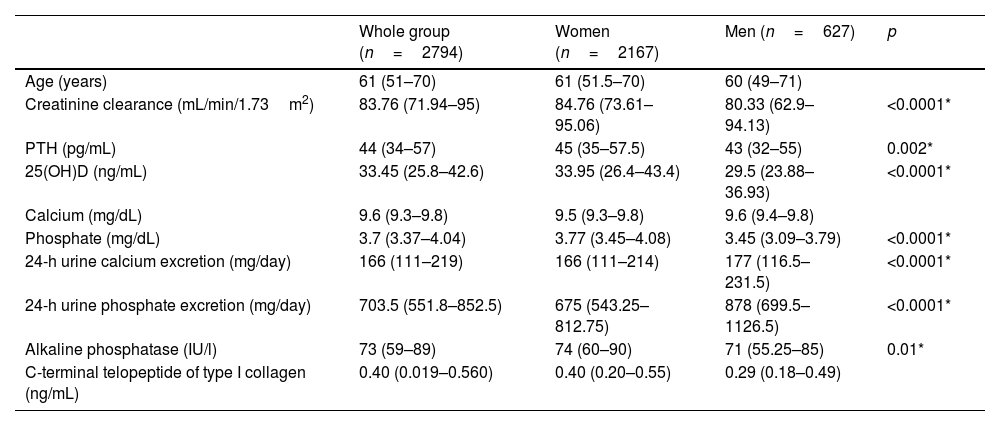Parathyroid hormone (PTH) and vitamin D are essential components in mineral metabolism. Our aims were to estimate the thresholds of 25-hydroxyvitamin D [25(OH)D] and estimated glomerular filtration rate (eGFR) that inhibit PTH, establish PTH reference intervals (RIs), and the stratify need based on age and gender.
Materials and methodsWe conducted a cross-sectional study on participants older than 18 years. Segmented regressions (SR) were performed to determine the thresholds of 25(OH)D and eGFR in relation to PTH levels. Multivariate regression was used to evaluate the associations between PTH and 25(OH)D, gender, age, eGFR, and season. To establish the PTH RIs, extreme percentiles were calculated.
ResultsA total of 2794 subjects were analyzed (women, 77.56%). Multivariate regression indicated that age, gender, 25(OH)D, and eGFR explained PTH variation. SR demonstrated that PTH stabilized when eGFR>46.64mL/min/1.73m2, and PTH increased when 25(OH)D was <15.8ng/mL. Stratification by gender and age revealed different RIs, with women and over 70 years showing higher limits.
ConclusionOur study suggests a stabilization point in PTH with an eGFR>46.64mL/min/1.73m2, indicating a significant interaction between renal function and PTH regulation. Additionally, the significant increase in PTH in individuals with 25(OH)D<15.8ng/mL emphasizes the importance of vitamin D in regulation. An association between age and PTH was also evident, particularly a substantial increase after the age of 70. Finally, we established the need to define partitioned RIs for PTH based on age and gender.
La hormona paratiroidea (PTH) y la vitamina D son componentes fundamentales en el metabolismo mineral. Nuestros objetivos fueron estimar los umbrales de 25-hidroxivitamina D [25(OH)D] y la tasa de filtración glomerular estimada (TFGe) que inhiben la PTH, establecer intervalos de referencia (IR) para la PTH y la necesidad de estratificar según la edad y el género.
Materiales y métodosSe realizó un estudio transversal en sujetos mayores de 18 años. Se llevaron a cabo regresiones segmentadas (RS) para determinar los umbrales de 25(OH)D y TFGe en relación con los niveles de PTH. La regresión multivariada se utilizó para evaluar las asociaciones entre PTH y 25(OH)D, género, edad, TFGe y estación. Para establecer los IR de PTH, se calcularon los percentiles extremos.
ResultadosSe analizaron 2.794 sujetos (mujeres 77,56%). La regresión multivariada indicó que la edad, el género, la 25(OH)D y el TFGe explican la variación de PTH. La RS demostró que la PTH se estabilizó cuando la TFGe superó los 46,64ml/min/1,73 m2 y la PTH aumentó cuando la 25(OH)D fue inferior a 15,8 ng/ml. La estratificación por género y edad reveló IR distintos, con mujeres y mayores de 70 años en los límites superiores.
ConclusiónNuestro estudio indica un punto de estabilización en la PTH con una TFGe superior a 46,64ml/min/1,73 m2, lo que indica una interacción significativa entre la función renal y la regulación de PTH. Además, el aumento significativo de PTH en individuos con 25(OH)D inferior a 15,8 ng/ml subraya la importancia de la vitamina D en la regulación. También se evidenció una asociación entre la edad y PTH, particularmente, un aumento sustancial después de los 70 años. Finalmente, establecimos la necesidad de definir IR partidos para PTH según edad y género.
Artículo
Comprando el artículo el PDF del mismo podrá ser descargado
Precio 19,34 €
Comprar ahora












